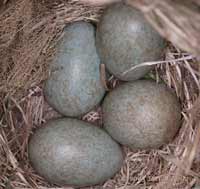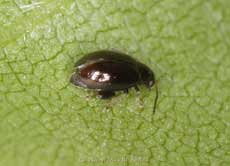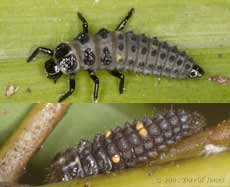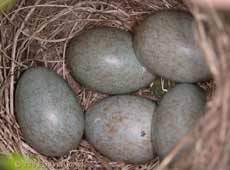Go to the last entry on this page ......Go to previous entry11 May - A dry, bright but cool day, most of which I spent at a car auction (as a supporter, not a buyer) - an interesting experience. Anyway, back to the garden, with a short update ...
In an effort to protect her and the nest I
have set up an electronic cat scarer so that its beam covers the area of the
West Wing. Only time will tell how effective it will be.
Under the trellis archway that I created by the shed, I have fixed up a small container into which I have been putting mealworms over the last week. It was sited especially to attract the Robin(s). My old friend the male with the white feather arrived almost straight away, and now turns up, perching in the Birch tree as I fill it up. This picture, taken this afternoon shows
his wing feathers quite nicely, including the normally un-noticed small
orange flashes at the ends of the coverts, the smaller feathers towards the
front edge of the wing. The dish is also used by the Sparrows, the female Blackbird, and the Blue Tits, although they also use their dedicated mealworm feeder which this year hangs under the caravan shelter instead of on the veranda.
In the meantime, the Bluebells are now well past their prime. The Triangular-stemmed Garlic are still doing well, as are the Wild Garlics, hidden behind them and which I forgot to mention when they came into flower on the 4th.
In addition to all the flowering plants, along the shady, southern edge of the garden there are ferns. Some of these already have well developed new fronds but others, like this one, are still unfurling. Click on images to see larger versions
12 May - A really pleasant sunny day, although it was breezy with occasional strong gusts. I couldn't get close to the Blackbird's nest until the middle of the afternoon as she has started to incubate her eggs. My bird guides say that the female starts sitting when the penultimate egg is laid, and this afternoon I was able to confirm the arrival of a fourth egg. Is this the last one, or will there be one more tomorrow? The lower right egg seems to have a crack-like line on it.
The first was this fly, which was under a leaf. The appearance of the front legs suggest that it is a male Hilara maura. The swellings produce silk. The male uses it to wrap up its prey which it then offers as a gift to a female during courtship.
The other insect was a tiny beetle just a couple of millimetres long, also on the underside of a leaf. The swollen hind leg indicates that it is a flea beetle, although I'm not going to guess which one.
On the last day of April I photographed a mating pair of 10-spot Ladybirds. In that case the male was red with black spots and the female was black with orange/yellow spots. As you can see, the colour variation is reversed in this pair, photographed this afternoon on the bamboo.
13 May - Another bright and breezy day with blue skies until the late afternoon. I haven't managed to sneak a photograph because she has been sitting on the nest nearly all the time, but I can confirm that the Blackbird has laid her fifth egg today.
She doesn't mind me moving about the West Wing, so I was able to take a look at the bamboo between jobs. The first visitor to grab my attention was this Hornet. Unfortunately, the blustery conditions meant that I wasn't able to get more than these two images before it left.
Despite the bamboos being blown about ladybirds continue to mate. Today I saw two pairs of 2-Spots. For the first time this year I spotted ladybird larvae, which isn't surprising considering how many pairs I have seen mating since the beginning of April. I think these are the larvae of 2-Spot Ladybirds.
The third 'bamboo' picture is an interesting one. The presence of aphids on the bamboos means that the leaves become coated with the sugary 'honeydew' that they excrete. Here, a bug isn't satisfied with the honeydew on the leaves. Instead, it is drinking the liquid directly from the rear end of an aphid.
The final image for today's diary is another of the Ink Cap fungus which is producing more fruiting bodies than previously. The image was captured via a front-silvered image.
14 May - A bright and dry, if rather cloudy day with North-easterly winds continuing from yesterday keeping it feeling quite cool.
It was at one of those moments, when she came to feed on raisins under the Hawthorn that I took advantage of her absence for just this one quick image.
They were together for quite some time,
although the third ladybird did leave his position to climb on top. It
looked as though he was trying to wrestle the other male away from the
female. His efforts didn't continue for long, and he soon returned to his
position at the rear of the group!
A daylight search of the Geranium leaves (under the Birch) revealed three Bush Crickets today (up to now I had only seen one). They are all a similar size, with a body length of about 3mm, slightly bigger than the first one I saw back on the 4th.
We had some very special visitors in the form of a television crew from the BBC Natural History Unit in Bristol recording an item for a forthcoming program called Breathing Space: Ultimate Garden, and due for broadcast on Thursday, 16 June. They spent some seven and a half hours with us, recording for an item which is scheduled to last just a minute and a half. It was a fascinating experience with a very friendly team of producer, camera man and sound man. As well as capturing some of our wildlife, they even had me performing in front of the camera!
For most of the day the weather was kind to us, despite a poor weather forecast. Rain caused a short period of disruption in the late afternoon, but it eased enough for the crew to get all the shots that they needed. We must now wait patiently to see what emerges from the cutting room!
The metallic iridescence of its small body is amazing in sunlight, the right hand image showing more clearly the ruby coloured tail as it enters a hole which measures about 2.5mm across. Tonight I can see that it is using the hole as a roost.
17 May - A dry, cool day and one when I did virtually nothing. After yesterday I feel shattered, and most of the time I was only watching the team working! I must now try to do some catching up, starting with the day-before-yesterday, which was about the nicest day we have had this year, warm, with pleasant sunshine and a slight breeze. There were lots of insects about and I managed to capture images of a few of them.
First was this small green beetle that came to me, landing on my top and staying long enough for me to get several shots. It appears to be one of the weevils, but I cannot pinpoint the species by using my guide books.
Next was this beetle that came to Sheila as we sat outside. It was obviously in a great hurry as it dashed about, so I had to confine it for a couple of minutes to get these images. It appears to be a Cantharis rustica, an abundant, predatory beetle that hunts amongst flowers of grassland, hedgerows and the edges of woodland.
It's a slightly blurred image, but I didn't get the chance of a second shot before it flew off. To give an idea of scale, the net mesh has a 1.25mm grid, which means the beetle is about 5mm long. The nearest match in my guides is Anthocomus fasciatus, although this individual seems to be too big to be that species.
The Ruby-tailed Wasp in yesterday's entry hasn't been seen today, perhaps because of the cooler temperatures. It wasn't the only parasitic wasp visiting the bee hotel over the last two days. I think it is Sapyga quinquepunctatum, the larvae of which are parasitic on Mason bees. The fact that this one has no red on its abdomen indicates that it is a male.
As I said at the beginning, today has not been very productive, but here are a trio of bird pictures.
When you arrive at the West Wing the first thing you see is just her beak poking up above the nest rim. Make a sound and her head rises up just enough to look out. With a bit of luck she will have a few moments of fame when the program is aired!
His loud singing can be heard for much of the day, but there are times when the song turns to its staccato alarm call. It usually indicates the presence of yet another cat in the neighbourhood, but it call also warn of a nearby Magpie, or even another Male Blackbird invading its territory. I have seen an other male chased away a couple of times over the last few days.
I haven't mentioned the Collared Doves lately. I haven't seen any sign of them nesting over the last few weeks, but they have started to feed here quite frequently at the moment, as have a pair of Wood Pigeons (after quite a long absence in their case).
Finally, and no pictures yet, the Goldfinches have started bringing juveniles to the feeders for the first time this year. Yesterday there were two here, but today I have only seen one. Being very nervous, the Goldfinches avoided the TV camera yesterday, appearing only while the crew was at the other end of the garden!
20 May - Over the last few days I have needed to turn my attention away from the garden and into the caravan. If you follow my diaries you'll remember that during our last trip to Cornwall, last September, we had a fire caused by a fan that overheated (and which my fire-fighter son says would have been within a minute or so of ending both our holiday, and us!!). Well, we are still here, and I am finally getting on with repairing the damage That job should be finished today - a sure sign that we will be heading West again in the near future.. Over the last few days the weather has gone somewhat downhill, with yesterday being wet and this morning starting off the same. The rain is welcome, and we need a lot more to avoid water shortages in the summer. For me, one annoying feature of rainy days at this time of the year is that I find that my 'hay-fever' symptoms are more pronounced. A walk down the garden between showers this morning has left me with itchy eyes and nose! Since mentioning the Goldfinch juveniles I haven't seen them, and the adults have been making fewer visits. Before I forget, I've just seen a Dunnock down to feed - a rare visit from a bird that used to be here all the time. As I write this at 8.45am the male Blackbird has just been feeding under the Hawthorn, and now he is back at the top of the conifers and 'singing in the rain'! All seems well in the nest - his partner's beak was the only clue to her presence when I checked a short time ago. There are more Ink Cap fungi appearing. Several popped up (and few over) yesterday and I can couple another eight appearing this morning. By lunchtime the rain had gone and we had a bright, sunny but blustery afternoon. In between finishing off the repairs in the caravan I took a bit of time to take a few photographs of plants that have come into flower this week.
I had hoped that they would have started flowering by the time the BBC crew came, but it wasn't until yesterday that the first petals unfolded.
Hidden amongst the daisy plants and the Red Campion there is a solitary White Campion plant in flower. This species first appeared here last September after I had planted wild flower seeds in the Spring.
In the background of the first photograph you can see a solitary purple flower. That is the first of the Geranium blossoms to open. Not a wild flower, but an annual home for the Bush Crickets. I could only see two crickets in the Geraniums today, although a couple of days ago I counted four.
Since last weekend (15th) a Field Buttercup right next to the veranda has been in flower, and I can now see several more in other parts of the garden.
Finally, the Foxglove that is tucked under the Hawthorn is also flowering now, although I'm not sure what day the first flower opened. I'm disappointed that we don't have a better display of foxgloves this year. In the past, lots of seeds were produced with little to show as a result.
Click on the images to see larger versions |
|




























